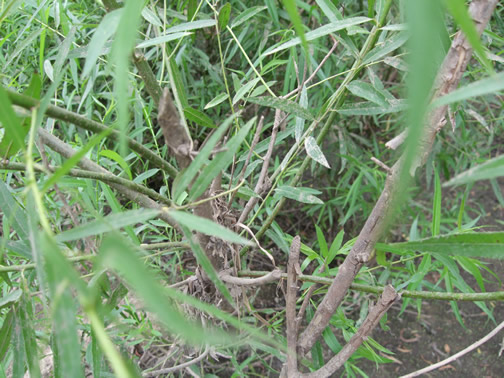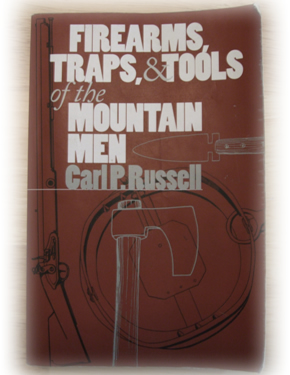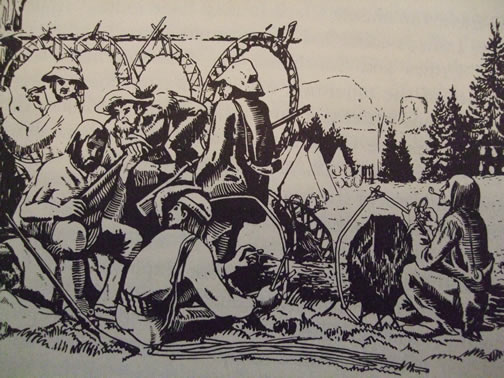This shade-intolerant species of willow
grows in dense thickets from spreading clones.
The full canopy produces a thick “jungle”,
forcing willows to grow straight and tall,
making good raw material for our hoops. |
|
Tree cutting is part of nature's cycle,
and beaver pruning stimulates willows to regrow
bushier than ever the next spring.
Look carefully at the base of this same plant
and you will see where beaver had chewed off
several stems in a prior season.
It is very possible ancestors of these very
sandbar willows were utilized by early trappers to
stretch their beaver pelts. |

|

|
Here is an excellent encyclopedic guide to the equipment of the early trappers. According to the text, 30 years of research went into the writing of this book. The author tracked down the diaries and letters of the trappers themselves, and the business records of fur-trading companies.
In the chapter on Beaver Traps and Trapping, there is an illustration showing some of the personnel of a large American trapper party in camp. According to the text, “It was common practice for trappers attached to large parties to bring their freshly skinned beaver pelts to the clerk of the camp, who credited the trapper.
‘Camp-Keepers’ then stretched the pelts on willow hoops and hung them to dry.” |
Explaining, Carl P. Russell wrote:
“The American Fur Company clerk Warren Angus Ferris provided an excellent eyewitness description of such a camp scene as shown above. On May 15, 1832, ‘in a narrow bottom beneath the walls of Grays Creek [near the sources of the Black River, Idaho] we found a party of trappers, headed by Bridger, one of the partners in the R.M.F. [Rocky Mountain Fur] Company. Their encampment was decked with hundreds of beaver skins, now drying in the sun. These valuable skins are always stretched in willow hoops, varying from eighteen inches to three feet in diameter, according to the size of the skins, and have a reddish appearance on the flesh side, which is exposed to the sun. Our camps are always dotted with these red circles in the trapping season when the weather is fair. There were several hundred skins folded and tied up in packs laying about their encampment.” [Western Literary Messenger, June 28, 1843, p. 406.] Mulcahy drawing, Jefferson National Expansion Memorial. |

Take a good look at these willow hoops in the illustration. Note they are oval, and not round. The beaver pelts that are stretched inside of them are adults or at least two-year olds. The pelt of a beaver kit is round. However, as a beaver grows and matures, the length of its pelt increases in size more rapidly than does the width. Therefore, the hoops stretching adult beaver should also reflect the change in shape of the beaver’s body. |

